Obesity Crisis: Analyzing the Role of Fast Food and Personal Choice
VerifiedAdded on 2023/06/03
|8
|3164
|426
Essay
AI Summary
This essay explores the complex issue of obesity, examining the role of fast food restaurants and individual responsibility. It delves into the history and culture of fast food, its economic impact, and its societal influence. The essay analyzes how fast food marketing and convenience contribute to unhealthy dietary choices, particularly among economically disadvantaged populations. It also contrasts fast food consumption with the World Health Organization's recommendations for healthy eating, highlighting the impact of processed foods, large portion sizes, and sedentary lifestyles. The essay concludes by emphasizing the need to address both individual behavior and the pervasive influence of the fast food industry to combat the obesity epidemic. Desklib provides access to similar essays and study resources for students.
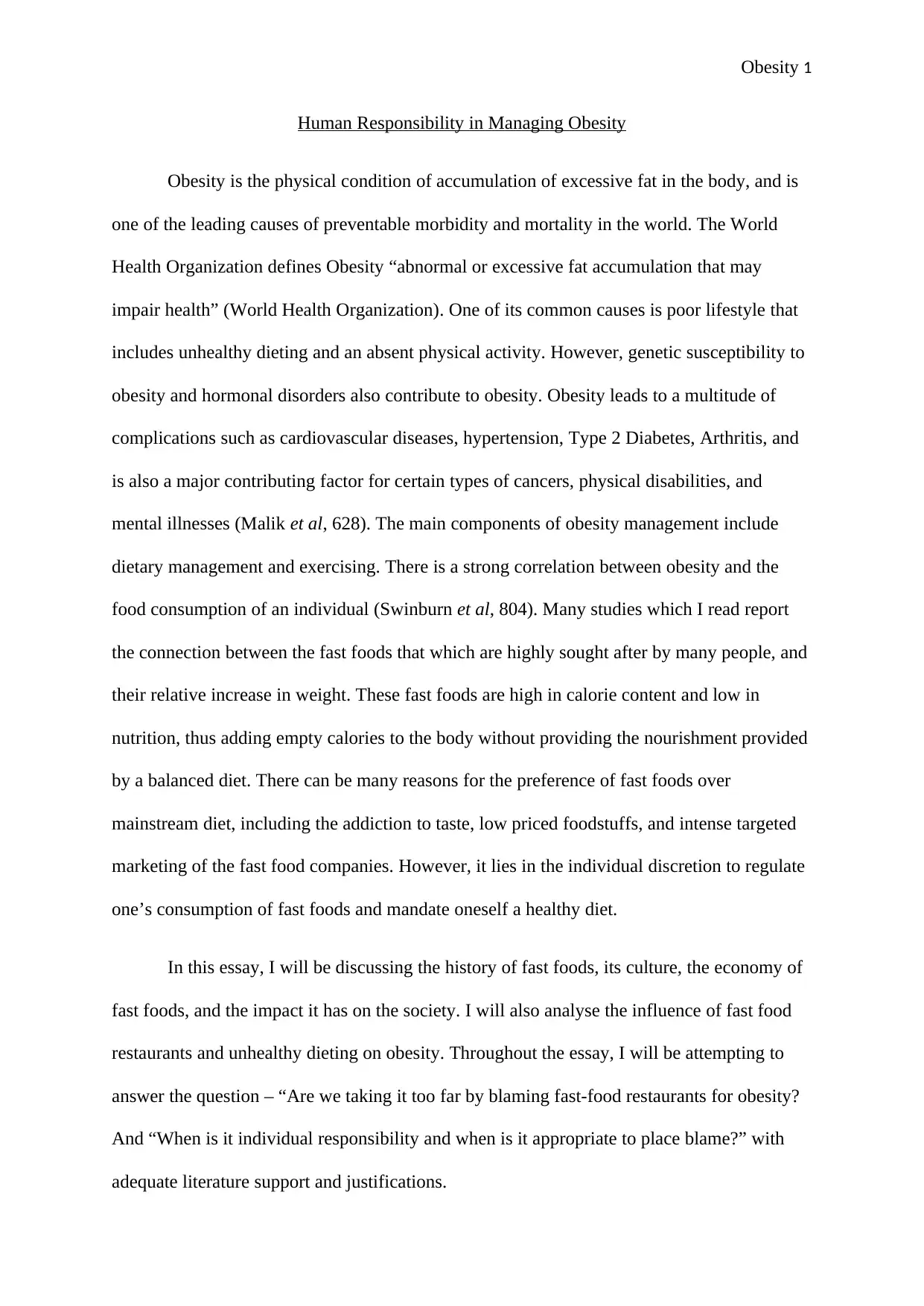
Obesity 1
Human Responsibility in Managing Obesity
Obesity is the physical condition of accumulation of excessive fat in the body, and is
one of the leading causes of preventable morbidity and mortality in the world. The World
Health Organization defines Obesity “abnormal or excessive fat accumulation that may
impair health” (World Health Organization). One of its common causes is poor lifestyle that
includes unhealthy dieting and an absent physical activity. However, genetic susceptibility to
obesity and hormonal disorders also contribute to obesity. Obesity leads to a multitude of
complications such as cardiovascular diseases, hypertension, Type 2 Diabetes, Arthritis, and
is also a major contributing factor for certain types of cancers, physical disabilities, and
mental illnesses (Malik et al, 628). The main components of obesity management include
dietary management and exercising. There is a strong correlation between obesity and the
food consumption of an individual (Swinburn et al, 804). Many studies which I read report
the connection between the fast foods that which are highly sought after by many people, and
their relative increase in weight. These fast foods are high in calorie content and low in
nutrition, thus adding empty calories to the body without providing the nourishment provided
by a balanced diet. There can be many reasons for the preference of fast foods over
mainstream diet, including the addiction to taste, low priced foodstuffs, and intense targeted
marketing of the fast food companies. However, it lies in the individual discretion to regulate
one’s consumption of fast foods and mandate oneself a healthy diet.
In this essay, I will be discussing the history of fast foods, its culture, the economy of
fast foods, and the impact it has on the society. I will also analyse the influence of fast food
restaurants and unhealthy dieting on obesity. Throughout the essay, I will be attempting to
answer the question – “Are we taking it too far by blaming fast-food restaurants for obesity?
And “When is it individual responsibility and when is it appropriate to place blame?” with
adequate literature support and justifications.
Human Responsibility in Managing Obesity
Obesity is the physical condition of accumulation of excessive fat in the body, and is
one of the leading causes of preventable morbidity and mortality in the world. The World
Health Organization defines Obesity “abnormal or excessive fat accumulation that may
impair health” (World Health Organization). One of its common causes is poor lifestyle that
includes unhealthy dieting and an absent physical activity. However, genetic susceptibility to
obesity and hormonal disorders also contribute to obesity. Obesity leads to a multitude of
complications such as cardiovascular diseases, hypertension, Type 2 Diabetes, Arthritis, and
is also a major contributing factor for certain types of cancers, physical disabilities, and
mental illnesses (Malik et al, 628). The main components of obesity management include
dietary management and exercising. There is a strong correlation between obesity and the
food consumption of an individual (Swinburn et al, 804). Many studies which I read report
the connection between the fast foods that which are highly sought after by many people, and
their relative increase in weight. These fast foods are high in calorie content and low in
nutrition, thus adding empty calories to the body without providing the nourishment provided
by a balanced diet. There can be many reasons for the preference of fast foods over
mainstream diet, including the addiction to taste, low priced foodstuffs, and intense targeted
marketing of the fast food companies. However, it lies in the individual discretion to regulate
one’s consumption of fast foods and mandate oneself a healthy diet.
In this essay, I will be discussing the history of fast foods, its culture, the economy of
fast foods, and the impact it has on the society. I will also analyse the influence of fast food
restaurants and unhealthy dieting on obesity. Throughout the essay, I will be attempting to
answer the question – “Are we taking it too far by blaming fast-food restaurants for obesity?
And “When is it individual responsibility and when is it appropriate to place blame?” with
adequate literature support and justifications.
Paraphrase This Document
Need a fresh take? Get an instant paraphrase of this document with our AI Paraphraser
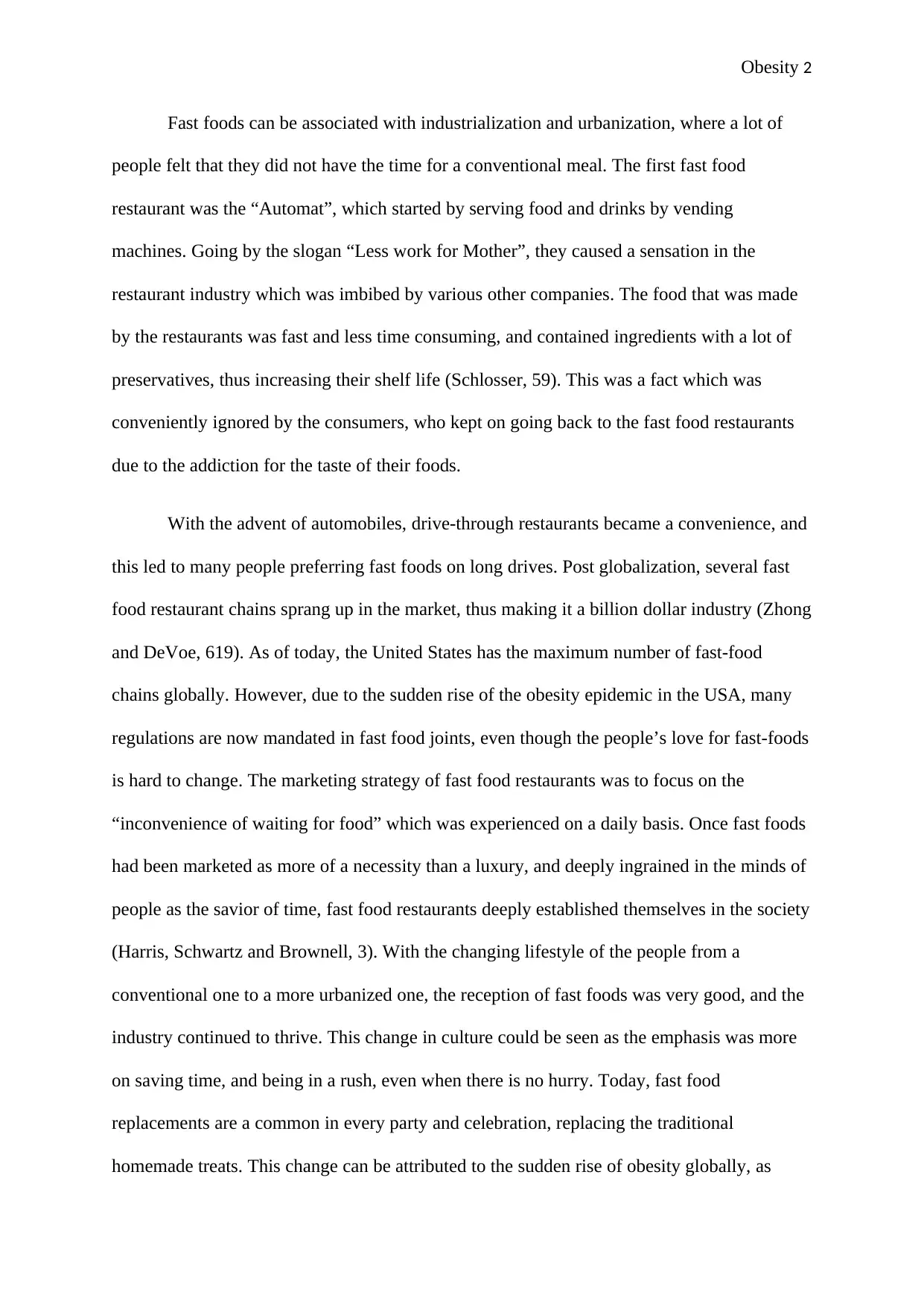
Obesity 2
Fast foods can be associated with industrialization and urbanization, where a lot of
people felt that they did not have the time for a conventional meal. The first fast food
restaurant was the “Automat”, which started by serving food and drinks by vending
machines. Going by the slogan “Less work for Mother”, they caused a sensation in the
restaurant industry which was imbibed by various other companies. The food that was made
by the restaurants was fast and less time consuming, and contained ingredients with a lot of
preservatives, thus increasing their shelf life (Schlosser, 59). This was a fact which was
conveniently ignored by the consumers, who kept on going back to the fast food restaurants
due to the addiction for the taste of their foods.
With the advent of automobiles, drive-through restaurants became a convenience, and
this led to many people preferring fast foods on long drives. Post globalization, several fast
food restaurant chains sprang up in the market, thus making it a billion dollar industry (Zhong
and DeVoe, 619). As of today, the United States has the maximum number of fast-food
chains globally. However, due to the sudden rise of the obesity epidemic in the USA, many
regulations are now mandated in fast food joints, even though the people’s love for fast-foods
is hard to change. The marketing strategy of fast food restaurants was to focus on the
“inconvenience of waiting for food” which was experienced on a daily basis. Once fast foods
had been marketed as more of a necessity than a luxury, and deeply ingrained in the minds of
people as the savior of time, fast food restaurants deeply established themselves in the society
(Harris, Schwartz and Brownell, 3). With the changing lifestyle of the people from a
conventional one to a more urbanized one, the reception of fast foods was very good, and the
industry continued to thrive. This change in culture could be seen as the emphasis was more
on saving time, and being in a rush, even when there is no hurry. Today, fast food
replacements are a common in every party and celebration, replacing the traditional
homemade treats. This change can be attributed to the sudden rise of obesity globally, as
Fast foods can be associated with industrialization and urbanization, where a lot of
people felt that they did not have the time for a conventional meal. The first fast food
restaurant was the “Automat”, which started by serving food and drinks by vending
machines. Going by the slogan “Less work for Mother”, they caused a sensation in the
restaurant industry which was imbibed by various other companies. The food that was made
by the restaurants was fast and less time consuming, and contained ingredients with a lot of
preservatives, thus increasing their shelf life (Schlosser, 59). This was a fact which was
conveniently ignored by the consumers, who kept on going back to the fast food restaurants
due to the addiction for the taste of their foods.
With the advent of automobiles, drive-through restaurants became a convenience, and
this led to many people preferring fast foods on long drives. Post globalization, several fast
food restaurant chains sprang up in the market, thus making it a billion dollar industry (Zhong
and DeVoe, 619). As of today, the United States has the maximum number of fast-food
chains globally. However, due to the sudden rise of the obesity epidemic in the USA, many
regulations are now mandated in fast food joints, even though the people’s love for fast-foods
is hard to change. The marketing strategy of fast food restaurants was to focus on the
“inconvenience of waiting for food” which was experienced on a daily basis. Once fast foods
had been marketed as more of a necessity than a luxury, and deeply ingrained in the minds of
people as the savior of time, fast food restaurants deeply established themselves in the society
(Harris, Schwartz and Brownell, 3). With the changing lifestyle of the people from a
conventional one to a more urbanized one, the reception of fast foods was very good, and the
industry continued to thrive. This change in culture could be seen as the emphasis was more
on saving time, and being in a rush, even when there is no hurry. Today, fast food
replacements are a common in every party and celebration, replacing the traditional
homemade treats. This change can be attributed to the sudden rise of obesity globally, as
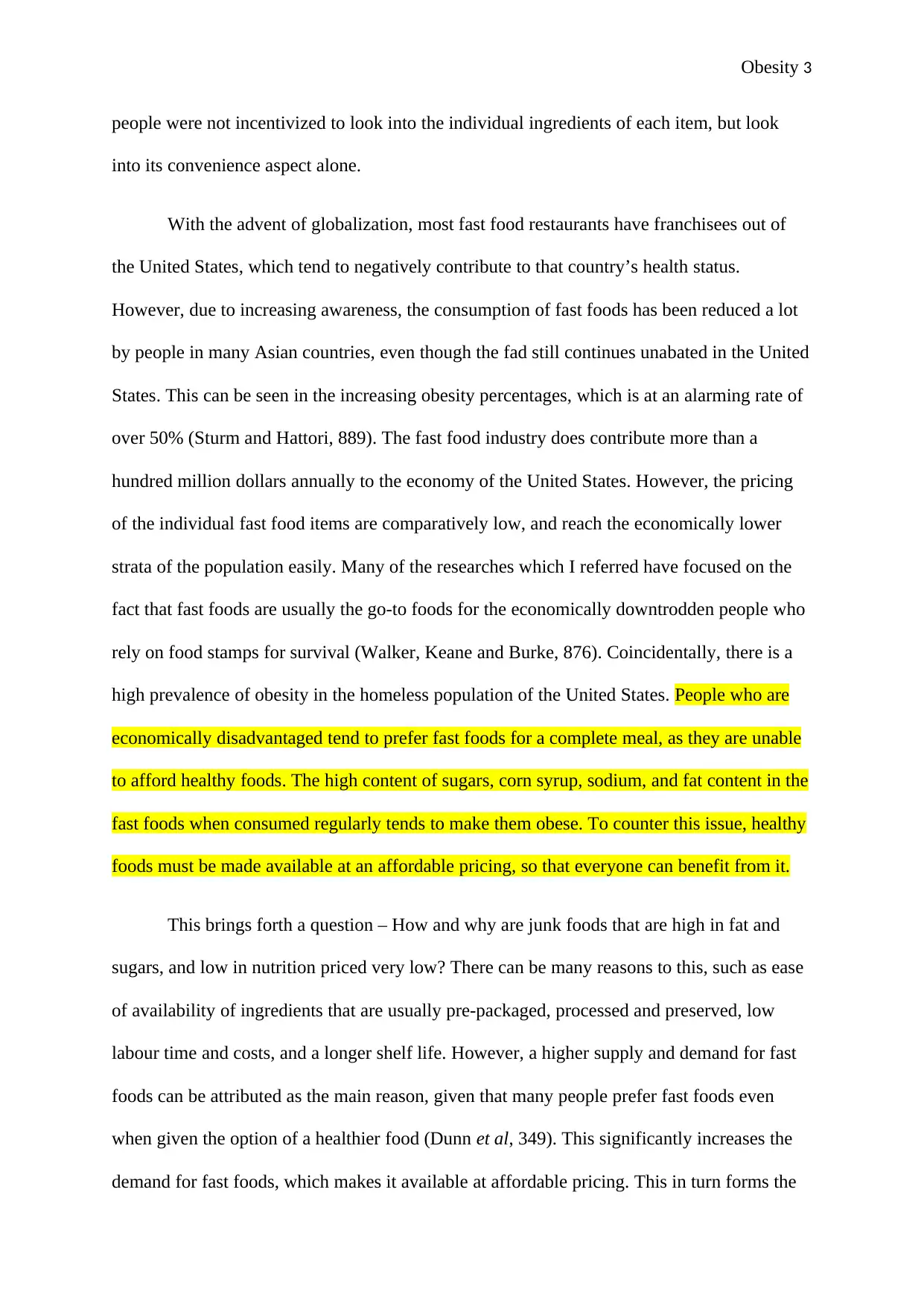
Obesity 3
people were not incentivized to look into the individual ingredients of each item, but look
into its convenience aspect alone.
With the advent of globalization, most fast food restaurants have franchisees out of
the United States, which tend to negatively contribute to that country’s health status.
However, due to increasing awareness, the consumption of fast foods has been reduced a lot
by people in many Asian countries, even though the fad still continues unabated in the United
States. This can be seen in the increasing obesity percentages, which is at an alarming rate of
over 50% (Sturm and Hattori, 889). The fast food industry does contribute more than a
hundred million dollars annually to the economy of the United States. However, the pricing
of the individual fast food items are comparatively low, and reach the economically lower
strata of the population easily. Many of the researches which I referred have focused on the
fact that fast foods are usually the go-to foods for the economically downtrodden people who
rely on food stamps for survival (Walker, Keane and Burke, 876). Coincidentally, there is a
high prevalence of obesity in the homeless population of the United States. People who are
economically disadvantaged tend to prefer fast foods for a complete meal, as they are unable
to afford healthy foods. The high content of sugars, corn syrup, sodium, and fat content in the
fast foods when consumed regularly tends to make them obese. To counter this issue, healthy
foods must be made available at an affordable pricing, so that everyone can benefit from it.
This brings forth a question – How and why are junk foods that are high in fat and
sugars, and low in nutrition priced very low? There can be many reasons to this, such as ease
of availability of ingredients that are usually pre-packaged, processed and preserved, low
labour time and costs, and a longer shelf life. However, a higher supply and demand for fast
foods can be attributed as the main reason, given that many people prefer fast foods even
when given the option of a healthier food (Dunn et al, 349). This significantly increases the
demand for fast foods, which makes it available at affordable pricing. This in turn forms the
people were not incentivized to look into the individual ingredients of each item, but look
into its convenience aspect alone.
With the advent of globalization, most fast food restaurants have franchisees out of
the United States, which tend to negatively contribute to that country’s health status.
However, due to increasing awareness, the consumption of fast foods has been reduced a lot
by people in many Asian countries, even though the fad still continues unabated in the United
States. This can be seen in the increasing obesity percentages, which is at an alarming rate of
over 50% (Sturm and Hattori, 889). The fast food industry does contribute more than a
hundred million dollars annually to the economy of the United States. However, the pricing
of the individual fast food items are comparatively low, and reach the economically lower
strata of the population easily. Many of the researches which I referred have focused on the
fact that fast foods are usually the go-to foods for the economically downtrodden people who
rely on food stamps for survival (Walker, Keane and Burke, 876). Coincidentally, there is a
high prevalence of obesity in the homeless population of the United States. People who are
economically disadvantaged tend to prefer fast foods for a complete meal, as they are unable
to afford healthy foods. The high content of sugars, corn syrup, sodium, and fat content in the
fast foods when consumed regularly tends to make them obese. To counter this issue, healthy
foods must be made available at an affordable pricing, so that everyone can benefit from it.
This brings forth a question – How and why are junk foods that are high in fat and
sugars, and low in nutrition priced very low? There can be many reasons to this, such as ease
of availability of ingredients that are usually pre-packaged, processed and preserved, low
labour time and costs, and a longer shelf life. However, a higher supply and demand for fast
foods can be attributed as the main reason, given that many people prefer fast foods even
when given the option of a healthier food (Dunn et al, 349). This significantly increases the
demand for fast foods, which makes it available at affordable pricing. This in turn forms the
⊘ This is a preview!⊘
Do you want full access?
Subscribe today to unlock all pages.

Trusted by 1+ million students worldwide
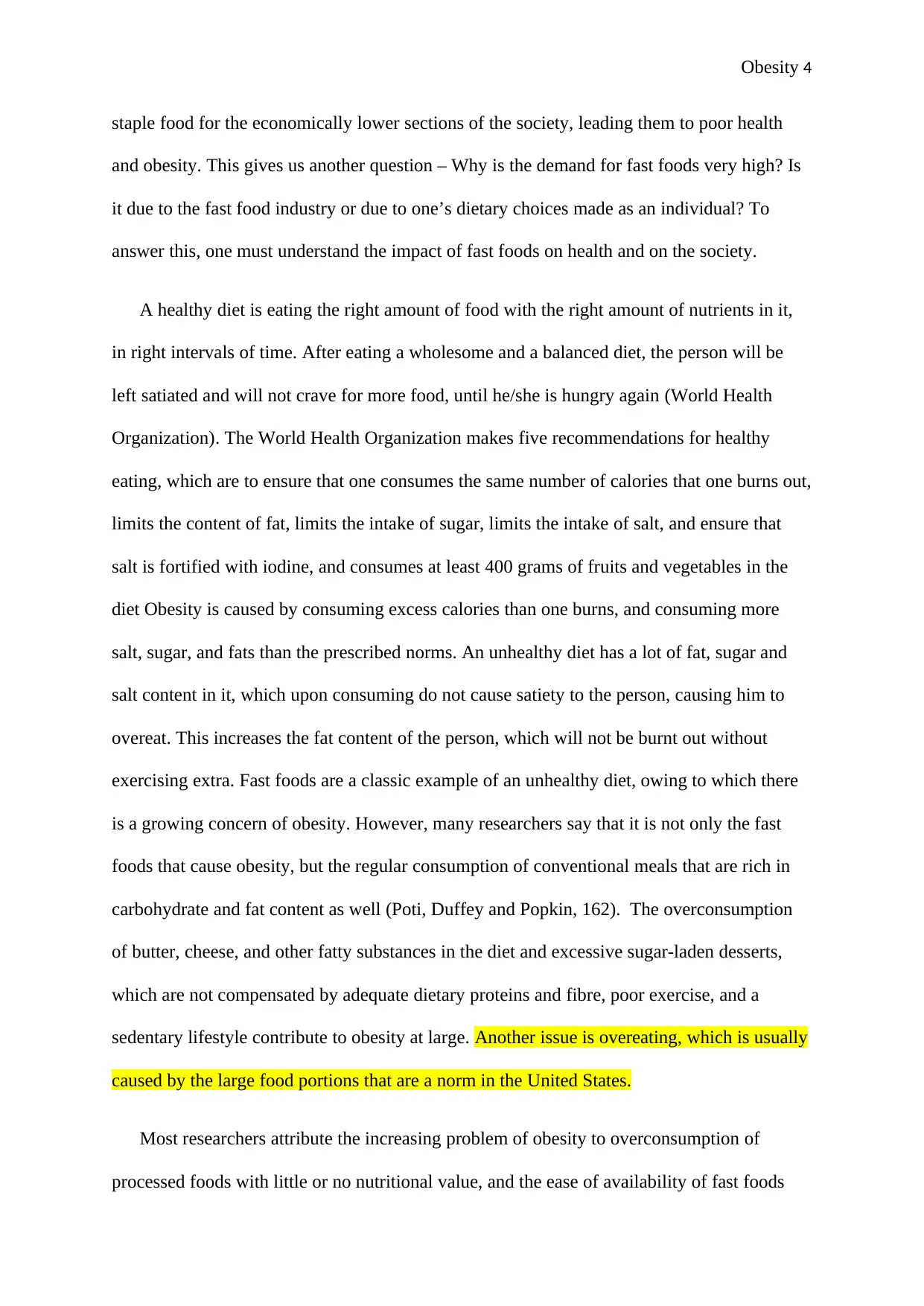
Obesity 4
staple food for the economically lower sections of the society, leading them to poor health
and obesity. This gives us another question – Why is the demand for fast foods very high? Is
it due to the fast food industry or due to one’s dietary choices made as an individual? To
answer this, one must understand the impact of fast foods on health and on the society.
A healthy diet is eating the right amount of food with the right amount of nutrients in it,
in right intervals of time. After eating a wholesome and a balanced diet, the person will be
left satiated and will not crave for more food, until he/she is hungry again (World Health
Organization). The World Health Organization makes five recommendations for healthy
eating, which are to ensure that one consumes the same number of calories that one burns out,
limits the content of fat, limits the intake of sugar, limits the intake of salt, and ensure that
salt is fortified with iodine, and consumes at least 400 grams of fruits and vegetables in the
diet Obesity is caused by consuming excess calories than one burns, and consuming more
salt, sugar, and fats than the prescribed norms. An unhealthy diet has a lot of fat, sugar and
salt content in it, which upon consuming do not cause satiety to the person, causing him to
overeat. This increases the fat content of the person, which will not be burnt out without
exercising extra. Fast foods are a classic example of an unhealthy diet, owing to which there
is a growing concern of obesity. However, many researchers say that it is not only the fast
foods that cause obesity, but the regular consumption of conventional meals that are rich in
carbohydrate and fat content as well (Poti, Duffey and Popkin, 162). The overconsumption
of butter, cheese, and other fatty substances in the diet and excessive sugar-laden desserts,
which are not compensated by adequate dietary proteins and fibre, poor exercise, and a
sedentary lifestyle contribute to obesity at large. Another issue is overeating, which is usually
caused by the large food portions that are a norm in the United States.
Most researchers attribute the increasing problem of obesity to overconsumption of
processed foods with little or no nutritional value, and the ease of availability of fast foods
staple food for the economically lower sections of the society, leading them to poor health
and obesity. This gives us another question – Why is the demand for fast foods very high? Is
it due to the fast food industry or due to one’s dietary choices made as an individual? To
answer this, one must understand the impact of fast foods on health and on the society.
A healthy diet is eating the right amount of food with the right amount of nutrients in it,
in right intervals of time. After eating a wholesome and a balanced diet, the person will be
left satiated and will not crave for more food, until he/she is hungry again (World Health
Organization). The World Health Organization makes five recommendations for healthy
eating, which are to ensure that one consumes the same number of calories that one burns out,
limits the content of fat, limits the intake of sugar, limits the intake of salt, and ensure that
salt is fortified with iodine, and consumes at least 400 grams of fruits and vegetables in the
diet Obesity is caused by consuming excess calories than one burns, and consuming more
salt, sugar, and fats than the prescribed norms. An unhealthy diet has a lot of fat, sugar and
salt content in it, which upon consuming do not cause satiety to the person, causing him to
overeat. This increases the fat content of the person, which will not be burnt out without
exercising extra. Fast foods are a classic example of an unhealthy diet, owing to which there
is a growing concern of obesity. However, many researchers say that it is not only the fast
foods that cause obesity, but the regular consumption of conventional meals that are rich in
carbohydrate and fat content as well (Poti, Duffey and Popkin, 162). The overconsumption
of butter, cheese, and other fatty substances in the diet and excessive sugar-laden desserts,
which are not compensated by adequate dietary proteins and fibre, poor exercise, and a
sedentary lifestyle contribute to obesity at large. Another issue is overeating, which is usually
caused by the large food portions that are a norm in the United States.
Most researchers attribute the increasing problem of obesity to overconsumption of
processed foods with little or no nutritional value, and the ease of availability of fast foods
Paraphrase This Document
Need a fresh take? Get an instant paraphrase of this document with our AI Paraphraser
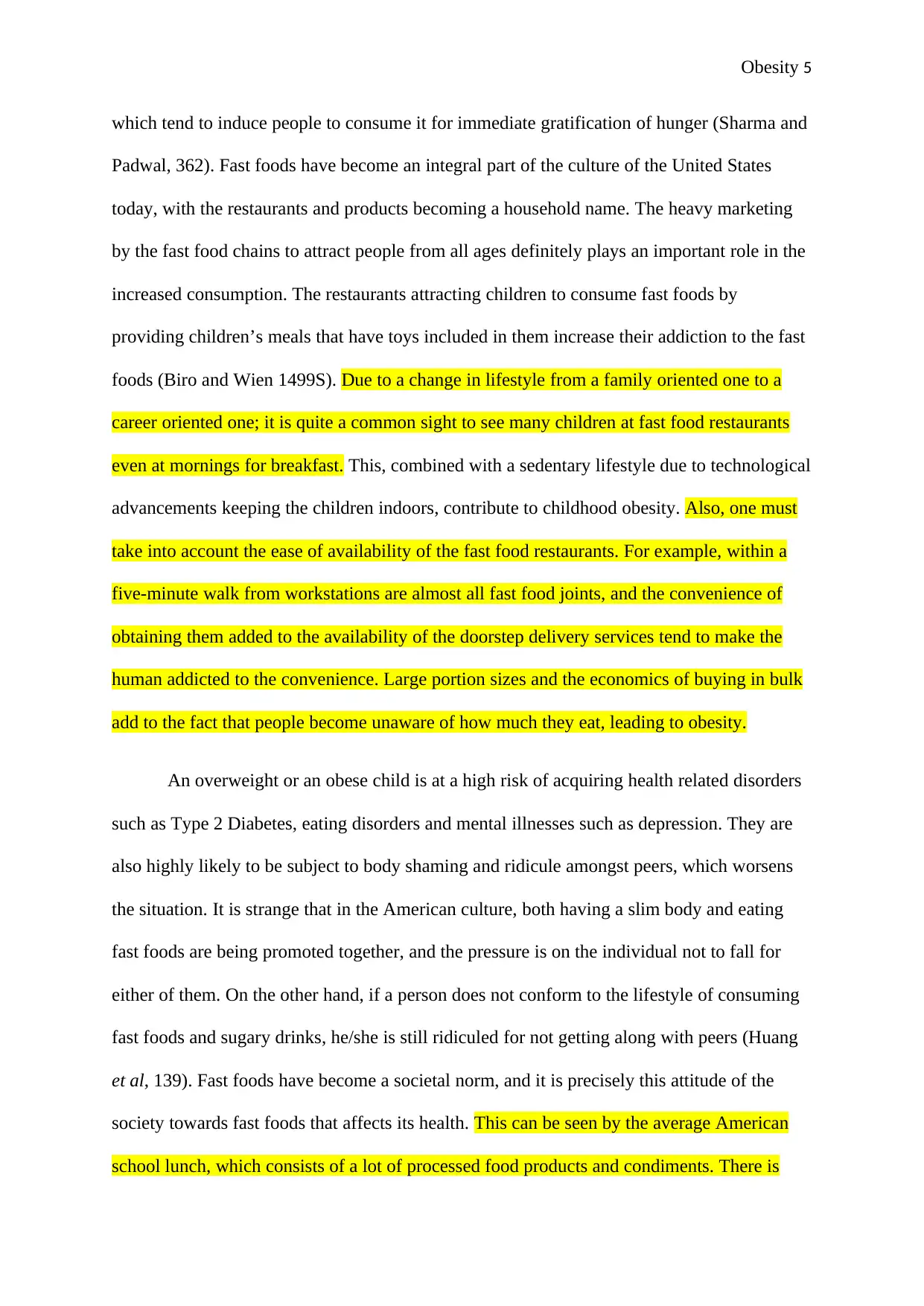
Obesity 5
which tend to induce people to consume it for immediate gratification of hunger (Sharma and
Padwal, 362). Fast foods have become an integral part of the culture of the United States
today, with the restaurants and products becoming a household name. The heavy marketing
by the fast food chains to attract people from all ages definitely plays an important role in the
increased consumption. The restaurants attracting children to consume fast foods by
providing children’s meals that have toys included in them increase their addiction to the fast
foods (Biro and Wien 1499S). Due to a change in lifestyle from a family oriented one to a
career oriented one; it is quite a common sight to see many children at fast food restaurants
even at mornings for breakfast. This, combined with a sedentary lifestyle due to technological
advancements keeping the children indoors, contribute to childhood obesity. Also, one must
take into account the ease of availability of the fast food restaurants. For example, within a
five-minute walk from workstations are almost all fast food joints, and the convenience of
obtaining them added to the availability of the doorstep delivery services tend to make the
human addicted to the convenience. Large portion sizes and the economics of buying in bulk
add to the fact that people become unaware of how much they eat, leading to obesity.
An overweight or an obese child is at a high risk of acquiring health related disorders
such as Type 2 Diabetes, eating disorders and mental illnesses such as depression. They are
also highly likely to be subject to body shaming and ridicule amongst peers, which worsens
the situation. It is strange that in the American culture, both having a slim body and eating
fast foods are being promoted together, and the pressure is on the individual not to fall for
either of them. On the other hand, if a person does not conform to the lifestyle of consuming
fast foods and sugary drinks, he/she is still ridiculed for not getting along with peers (Huang
et al, 139). Fast foods have become a societal norm, and it is precisely this attitude of the
society towards fast foods that affects its health. This can be seen by the average American
school lunch, which consists of a lot of processed food products and condiments. There is
which tend to induce people to consume it for immediate gratification of hunger (Sharma and
Padwal, 362). Fast foods have become an integral part of the culture of the United States
today, with the restaurants and products becoming a household name. The heavy marketing
by the fast food chains to attract people from all ages definitely plays an important role in the
increased consumption. The restaurants attracting children to consume fast foods by
providing children’s meals that have toys included in them increase their addiction to the fast
foods (Biro and Wien 1499S). Due to a change in lifestyle from a family oriented one to a
career oriented one; it is quite a common sight to see many children at fast food restaurants
even at mornings for breakfast. This, combined with a sedentary lifestyle due to technological
advancements keeping the children indoors, contribute to childhood obesity. Also, one must
take into account the ease of availability of the fast food restaurants. For example, within a
five-minute walk from workstations are almost all fast food joints, and the convenience of
obtaining them added to the availability of the doorstep delivery services tend to make the
human addicted to the convenience. Large portion sizes and the economics of buying in bulk
add to the fact that people become unaware of how much they eat, leading to obesity.
An overweight or an obese child is at a high risk of acquiring health related disorders
such as Type 2 Diabetes, eating disorders and mental illnesses such as depression. They are
also highly likely to be subject to body shaming and ridicule amongst peers, which worsens
the situation. It is strange that in the American culture, both having a slim body and eating
fast foods are being promoted together, and the pressure is on the individual not to fall for
either of them. On the other hand, if a person does not conform to the lifestyle of consuming
fast foods and sugary drinks, he/she is still ridiculed for not getting along with peers (Huang
et al, 139). Fast foods have become a societal norm, and it is precisely this attitude of the
society towards fast foods that affects its health. This can be seen by the average American
school lunch, which consists of a lot of processed food products and condiments. There is
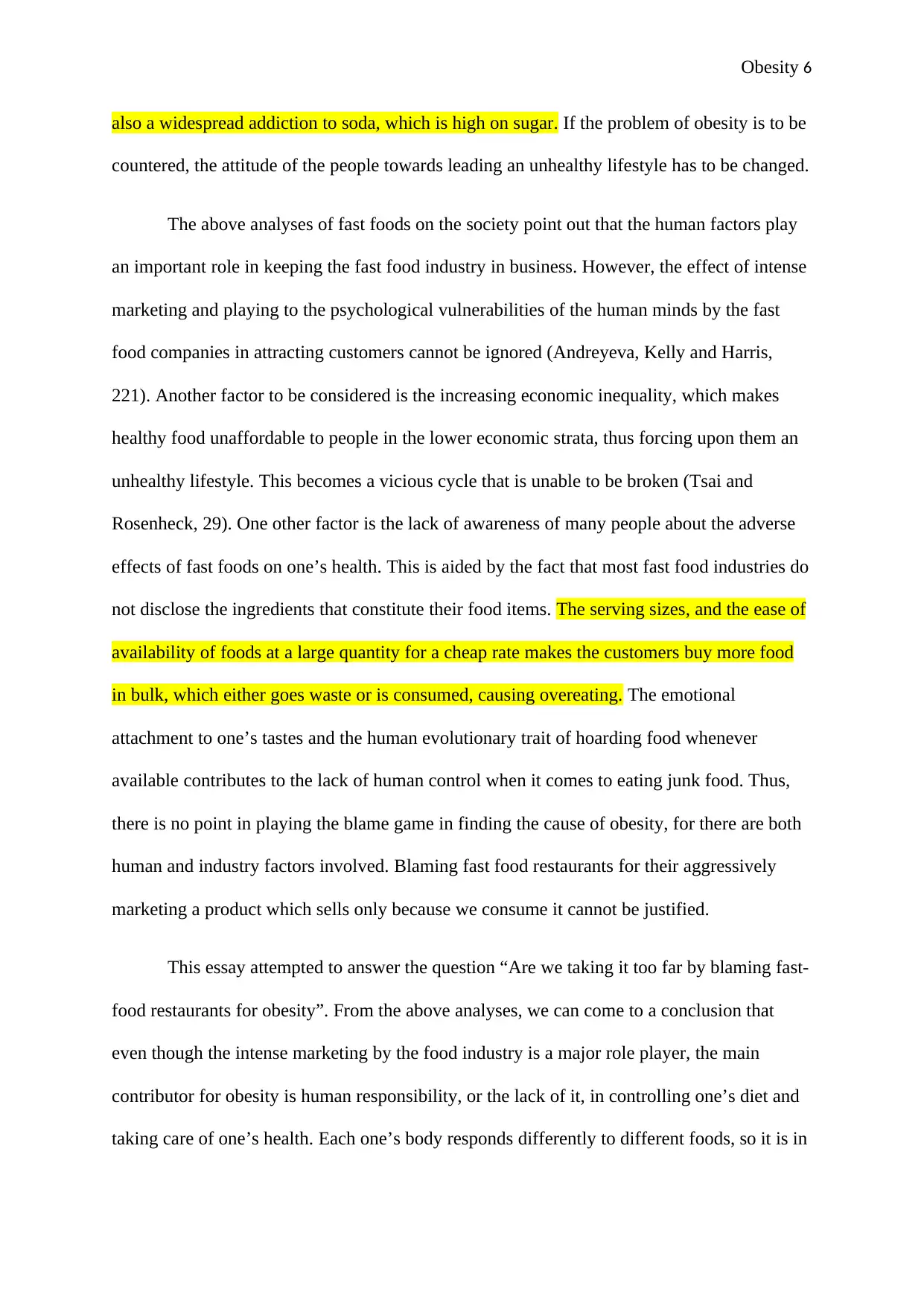
Obesity 6
also a widespread addiction to soda, which is high on sugar. If the problem of obesity is to be
countered, the attitude of the people towards leading an unhealthy lifestyle has to be changed.
The above analyses of fast foods on the society point out that the human factors play
an important role in keeping the fast food industry in business. However, the effect of intense
marketing and playing to the psychological vulnerabilities of the human minds by the fast
food companies in attracting customers cannot be ignored (Andreyeva, Kelly and Harris,
221). Another factor to be considered is the increasing economic inequality, which makes
healthy food unaffordable to people in the lower economic strata, thus forcing upon them an
unhealthy lifestyle. This becomes a vicious cycle that is unable to be broken (Tsai and
Rosenheck, 29). One other factor is the lack of awareness of many people about the adverse
effects of fast foods on one’s health. This is aided by the fact that most fast food industries do
not disclose the ingredients that constitute their food items. The serving sizes, and the ease of
availability of foods at a large quantity for a cheap rate makes the customers buy more food
in bulk, which either goes waste or is consumed, causing overeating. The emotional
attachment to one’s tastes and the human evolutionary trait of hoarding food whenever
available contributes to the lack of human control when it comes to eating junk food. Thus,
there is no point in playing the blame game in finding the cause of obesity, for there are both
human and industry factors involved. Blaming fast food restaurants for their aggressively
marketing a product which sells only because we consume it cannot be justified.
This essay attempted to answer the question “Are we taking it too far by blaming fast-
food restaurants for obesity”. From the above analyses, we can come to a conclusion that
even though the intense marketing by the food industry is a major role player, the main
contributor for obesity is human responsibility, or the lack of it, in controlling one’s diet and
taking care of one’s health. Each one’s body responds differently to different foods, so it is in
also a widespread addiction to soda, which is high on sugar. If the problem of obesity is to be
countered, the attitude of the people towards leading an unhealthy lifestyle has to be changed.
The above analyses of fast foods on the society point out that the human factors play
an important role in keeping the fast food industry in business. However, the effect of intense
marketing and playing to the psychological vulnerabilities of the human minds by the fast
food companies in attracting customers cannot be ignored (Andreyeva, Kelly and Harris,
221). Another factor to be considered is the increasing economic inequality, which makes
healthy food unaffordable to people in the lower economic strata, thus forcing upon them an
unhealthy lifestyle. This becomes a vicious cycle that is unable to be broken (Tsai and
Rosenheck, 29). One other factor is the lack of awareness of many people about the adverse
effects of fast foods on one’s health. This is aided by the fact that most fast food industries do
not disclose the ingredients that constitute their food items. The serving sizes, and the ease of
availability of foods at a large quantity for a cheap rate makes the customers buy more food
in bulk, which either goes waste or is consumed, causing overeating. The emotional
attachment to one’s tastes and the human evolutionary trait of hoarding food whenever
available contributes to the lack of human control when it comes to eating junk food. Thus,
there is no point in playing the blame game in finding the cause of obesity, for there are both
human and industry factors involved. Blaming fast food restaurants for their aggressively
marketing a product which sells only because we consume it cannot be justified.
This essay attempted to answer the question “Are we taking it too far by blaming fast-
food restaurants for obesity”. From the above analyses, we can come to a conclusion that
even though the intense marketing by the food industry is a major role player, the main
contributor for obesity is human responsibility, or the lack of it, in controlling one’s diet and
taking care of one’s health. Each one’s body responds differently to different foods, so it is in
⊘ This is a preview!⊘
Do you want full access?
Subscribe today to unlock all pages.

Trusted by 1+ million students worldwide
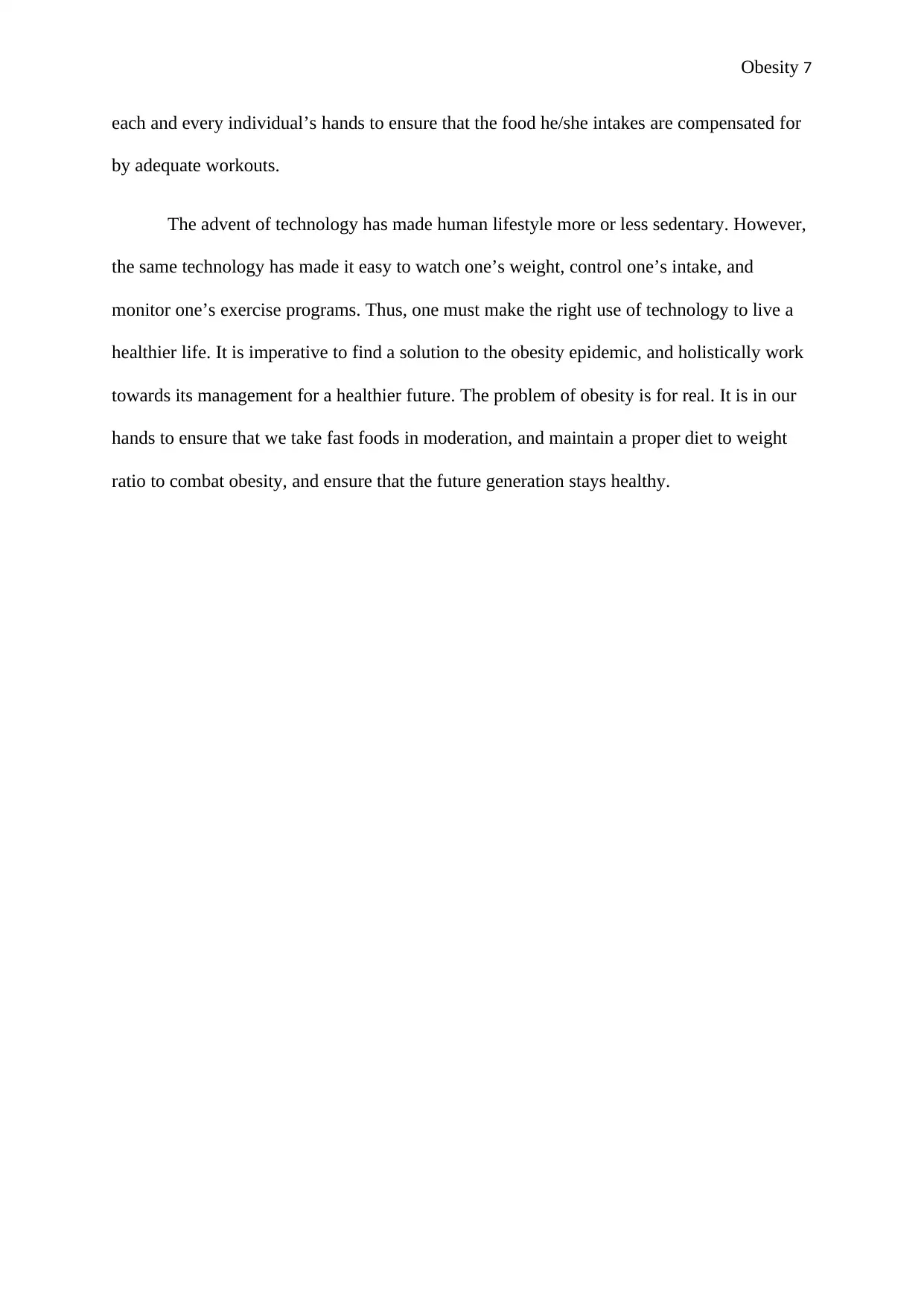
Obesity 7
each and every individual’s hands to ensure that the food he/she intakes are compensated for
by adequate workouts.
The advent of technology has made human lifestyle more or less sedentary. However,
the same technology has made it easy to watch one’s weight, control one’s intake, and
monitor one’s exercise programs. Thus, one must make the right use of technology to live a
healthier life. It is imperative to find a solution to the obesity epidemic, and holistically work
towards its management for a healthier future. The problem of obesity is for real. It is in our
hands to ensure that we take fast foods in moderation, and maintain a proper diet to weight
ratio to combat obesity, and ensure that the future generation stays healthy.
each and every individual’s hands to ensure that the food he/she intakes are compensated for
by adequate workouts.
The advent of technology has made human lifestyle more or less sedentary. However,
the same technology has made it easy to watch one’s weight, control one’s intake, and
monitor one’s exercise programs. Thus, one must make the right use of technology to live a
healthier life. It is imperative to find a solution to the obesity epidemic, and holistically work
towards its management for a healthier future. The problem of obesity is for real. It is in our
hands to ensure that we take fast foods in moderation, and maintain a proper diet to weight
ratio to combat obesity, and ensure that the future generation stays healthy.
Paraphrase This Document
Need a fresh take? Get an instant paraphrase of this document with our AI Paraphraser
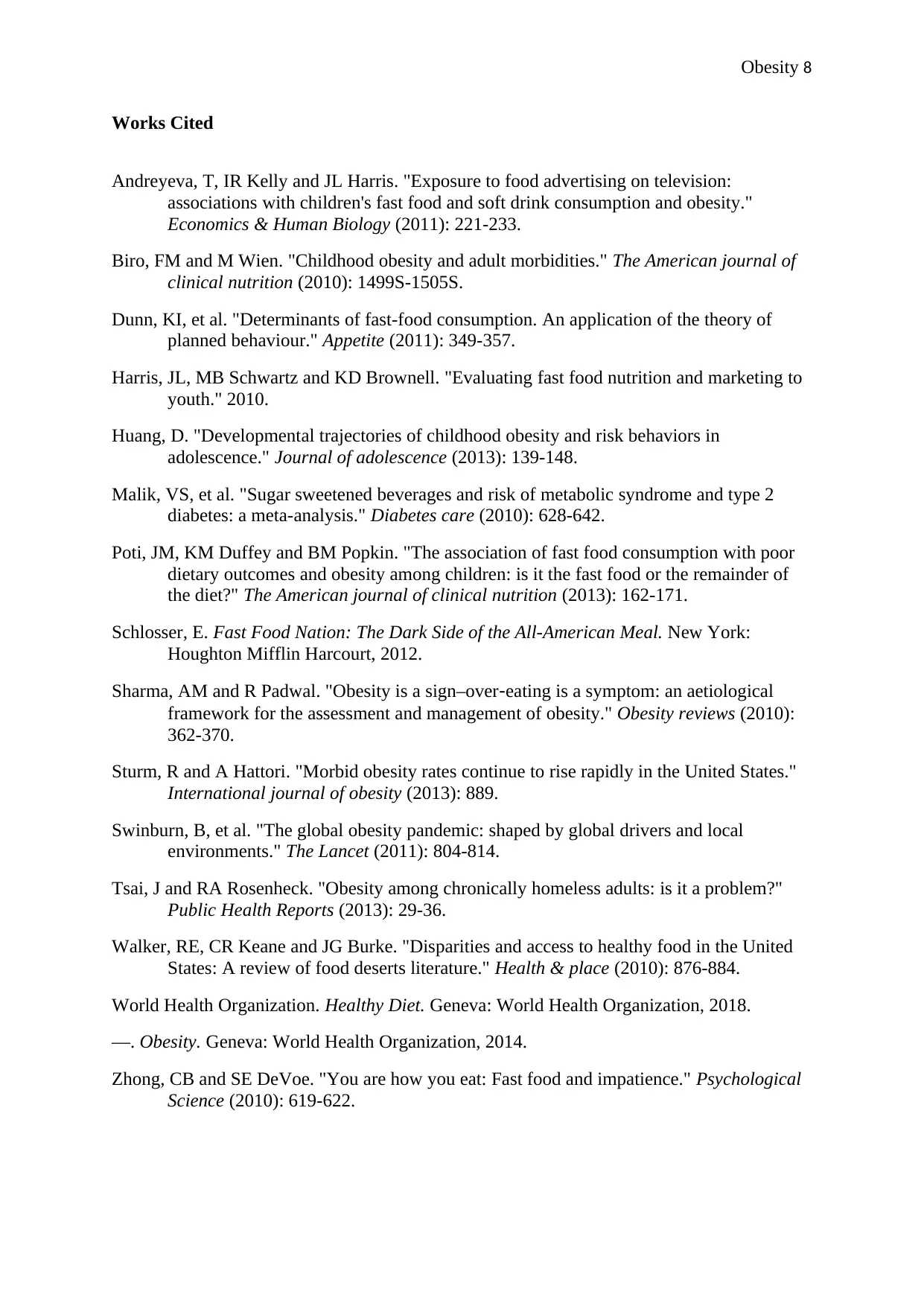
Obesity 8
Works Cited
Andreyeva, T, IR Kelly and JL Harris. "Exposure to food advertising on television:
associations with children's fast food and soft drink consumption and obesity."
Economics & Human Biology (2011): 221-233.
Biro, FM and M Wien. "Childhood obesity and adult morbidities." The American journal of
clinical nutrition (2010): 1499S-1505S.
Dunn, KI, et al. "Determinants of fast-food consumption. An application of the theory of
planned behaviour." Appetite (2011): 349-357.
Harris, JL, MB Schwartz and KD Brownell. "Evaluating fast food nutrition and marketing to
youth." 2010.
Huang, D. "Developmental trajectories of childhood obesity and risk behaviors in
adolescence." Journal of adolescence (2013): 139-148.
Malik, VS, et al. "Sugar sweetened beverages and risk of metabolic syndrome and type 2
diabetes: a meta-analysis." Diabetes care (2010): 628-642.
Poti, JM, KM Duffey and BM Popkin. "The association of fast food consumption with poor
dietary outcomes and obesity among children: is it the fast food or the remainder of
the diet?" The American journal of clinical nutrition (2013): 162-171.
Schlosser, E. Fast Food Nation: The Dark Side of the All-American Meal. New York:
Houghton Mifflin Harcourt, 2012.
Sharma, AM and R Padwal. "Obesity is a sign–over‐eating is a symptom: an aetiological
framework for the assessment and management of obesity." Obesity reviews (2010):
362-370.
Sturm, R and A Hattori. "Morbid obesity rates continue to rise rapidly in the United States."
International journal of obesity (2013): 889.
Swinburn, B, et al. "The global obesity pandemic: shaped by global drivers and local
environments." The Lancet (2011): 804-814.
Tsai, J and RA Rosenheck. "Obesity among chronically homeless adults: is it a problem?"
Public Health Reports (2013): 29-36.
Walker, RE, CR Keane and JG Burke. "Disparities and access to healthy food in the United
States: A review of food deserts literature." Health & place (2010): 876-884.
World Health Organization. Healthy Diet. Geneva: World Health Organization, 2018.
—. Obesity. Geneva: World Health Organization, 2014.
Zhong, CB and SE DeVoe. "You are how you eat: Fast food and impatience." Psychological
Science (2010): 619-622.
Works Cited
Andreyeva, T, IR Kelly and JL Harris. "Exposure to food advertising on television:
associations with children's fast food and soft drink consumption and obesity."
Economics & Human Biology (2011): 221-233.
Biro, FM and M Wien. "Childhood obesity and adult morbidities." The American journal of
clinical nutrition (2010): 1499S-1505S.
Dunn, KI, et al. "Determinants of fast-food consumption. An application of the theory of
planned behaviour." Appetite (2011): 349-357.
Harris, JL, MB Schwartz and KD Brownell. "Evaluating fast food nutrition and marketing to
youth." 2010.
Huang, D. "Developmental trajectories of childhood obesity and risk behaviors in
adolescence." Journal of adolescence (2013): 139-148.
Malik, VS, et al. "Sugar sweetened beverages and risk of metabolic syndrome and type 2
diabetes: a meta-analysis." Diabetes care (2010): 628-642.
Poti, JM, KM Duffey and BM Popkin. "The association of fast food consumption with poor
dietary outcomes and obesity among children: is it the fast food or the remainder of
the diet?" The American journal of clinical nutrition (2013): 162-171.
Schlosser, E. Fast Food Nation: The Dark Side of the All-American Meal. New York:
Houghton Mifflin Harcourt, 2012.
Sharma, AM and R Padwal. "Obesity is a sign–over‐eating is a symptom: an aetiological
framework for the assessment and management of obesity." Obesity reviews (2010):
362-370.
Sturm, R and A Hattori. "Morbid obesity rates continue to rise rapidly in the United States."
International journal of obesity (2013): 889.
Swinburn, B, et al. "The global obesity pandemic: shaped by global drivers and local
environments." The Lancet (2011): 804-814.
Tsai, J and RA Rosenheck. "Obesity among chronically homeless adults: is it a problem?"
Public Health Reports (2013): 29-36.
Walker, RE, CR Keane and JG Burke. "Disparities and access to healthy food in the United
States: A review of food deserts literature." Health & place (2010): 876-884.
World Health Organization. Healthy Diet. Geneva: World Health Organization, 2018.
—. Obesity. Geneva: World Health Organization, 2014.
Zhong, CB and SE DeVoe. "You are how you eat: Fast food and impatience." Psychological
Science (2010): 619-622.
1 out of 8
Related Documents
Your All-in-One AI-Powered Toolkit for Academic Success.
+13062052269
info@desklib.com
Available 24*7 on WhatsApp / Email
![[object Object]](/_next/static/media/star-bottom.7253800d.svg)
Unlock your academic potential
Copyright © 2020–2025 A2Z Services. All Rights Reserved. Developed and managed by ZUCOL.





